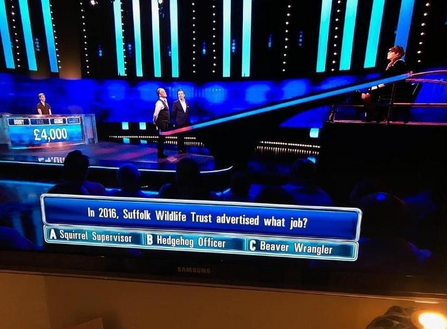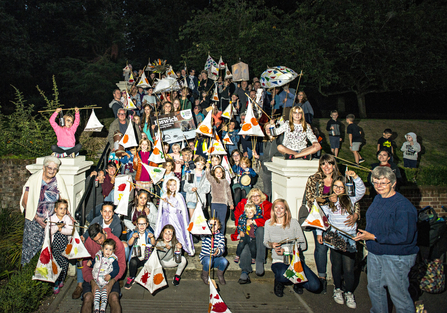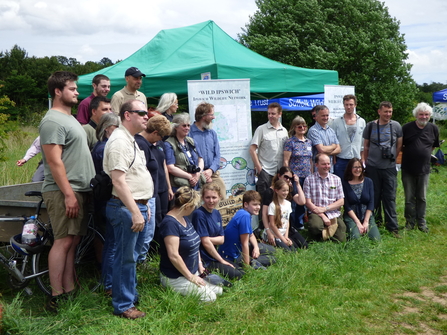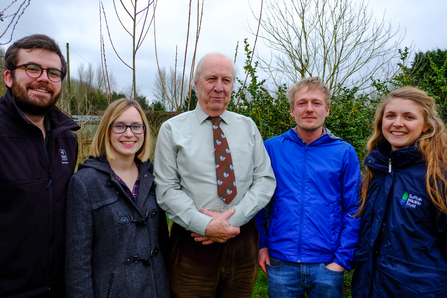I joined the conservation team back in September 2016 and it was certainly a whirlwind start. The job advert had caught the attention of international media, with articles being published across 13 countries, including New Zealand, the USA and Taiwan. There was even a question featuring the new job role on the game show The Chase.
Reflecting on my time as Ipswich Hedgehog Officer
Photo by Ali North

Since then we've been able to promote our project and the work of our Hedgehog Champions through a range of media outlets. We were lucky enough to feature on the Channel 5 Steve Backshall ‘Meet the hedgehogs’ documentary, Countryfile, BBC Look East and ITV East Anglia. Our project has featured in over 60 print or online articles, over 20 radio interviews and even in two books – ‘Hedgehogs’ by renowned hedgehog expert Pat Morris, and the RSPB Spotlight – Hedgehogs by James Lowen. I was especially excited when the project was able to feature on CBBC Newsround; I’d grown up watching this after school!
The people of Ipswich care about hedgehogs
The residents of Ipswich have certainly embraced our project and it has been inspiring to meet so many people willing to take action. Whether it’s a childhood memory or a regular visitor to the garden, everyone has a hedgehog story to tell.
Over 6,000 people have been directly involved in our hedgehog work in Ipswich, whether this is from attending an evening talk, night walk, community event or workshop. Over 400 people have been involved in our footprint surveys and we’ve worked with over 200 ecologists, planners and land managers.
But that’s just the numbers. I’ve met some amazing people throughout this project. One couple had set up garden CCTV 'hog cams' and would tune into this instead of watching TV adverts. One lady had tears of happiness when I showed her a hedgehog video clip recorded in her garden. Multiple residents within our population research study areas would stay up late and phone us in the middle of the night to tell us they’d seen a marked hedgehog that they knew we needed to give a health check. Several people have kept daily diaries recording the hedgehog visitors to their garden, with dates, times and behaviours. Scout leaders have run hedgehog-themed groups for their peers and wildlife ambassadors have spent hours designing, colouring and delivering home-made leaflets to their neighbours. Several people have written letters to their neighbours and pubs have made us banquets of hedgehog-themed nibbles for our events.
Schools have gone above and beyond to help hedgehogs; whole day hedgehog-themed curriculum’s, making hedgehog homes, wildflower strips, feeding stations and even getting the design technology team to create a hedgehog house as a direct replica of the school building. Hedgehog window stickers and keyrings have been created and stalls have been run. Groups of neighbours have invited me for tea and cake to tell me about the hedgehog survey they had conducted along their street. Ecologists and planners have travelled across the county for our workshops and Ipswich Borough Council have incorporated hedgehogs into their management plans. Hedgehog champions have walked from door to door persuading their neighbours to connect their gardens, and lovely afternoons have been spent with groups of neighbours chatting about hedgehogs whilst drilling hedgehog-sized holes through walled gardens. A young girl told me that she wanted to be a Hedgehog Officer when she grew up and asked what she needed to do to make it happen.

To celebrate hedgehogs at the end of our external funding period we invited the residents of Ipswich to a hedgehog lantern parade - the first of its kind! We weaved our way through Holywells Park at twilight, ending at La Tour Cycle Café along the waterfront for drinks, cake and hedgehog chatter. Photo by John Ferguson.
I’ve also had the pleasure of meeting some amazing volunteers. Our hedgehog volunteers have contributed over 1000 hours and have collectively walked over 400km for hedgehogs. These night soirees in search of hedgehogs were sometimes to no avail, but our volunteers were dedicated to the cause. They’ve chatted to members of the public, canvassed garden owners for research, helped conduct footprint tunnel surveys and radio tracked animals across the streets of Ipswich.
Our four interns – Jo, Carol, Chloe and Sarah – were also incredible, and helped me with field work that would have been impossible without them. Chloe has since been studying meerkats in the Kalahari and Sarah has been championing hedgehogs within Ipswich Borough Council. Carol recently got in touch to say that she had persuaded her employers to create a Hedgehog Highway on their land and Jo has gone on to set up a Hedgehog Friendly Campus initiative at Sheffield University, which subsequently became a national campaign funded by British Hedgehog Preservation Society.
The hedgehogs of Ipswich
We have worked hard to establish two field sites, with two field seasons contributing to hedgehog population research for Nottingham Trent University. The research, funded by People’s Trust for Endangered Species and British Hedgehog Preservation Society, aimed to validate a method of estimating hedgehog population density. Our field work brought us into contact with a wide cross section of the Ipswich community, and was also a chance to get up close and personal with lots of beautiful hogs!
Although we have given health checks, marked or tagged nearly 50 unique individuals in the past two years, there are two particular hedgehogs that stick in my mind. The first is ‘Adventure Hog’, or more formerly known as Blue 'A' Male. This chap travelled far and wide and was very difficult to keep track of. He eventually led us out of town into the dead of night, searching eerily lit church yards and dark alleyways. We finally found him as he darted across the road in front of the van. We quickly pulled up and ran full pelt to capture him for a health check before he vanished into a garden. His last parting gift was the shedding of his tag in the densest bush known to mankind. At one point I was suspended horizontally, twigs firmly tangled through my hair, wondering if I was going to find the tag, or even escape the holds of the branches to see daylight once more. Eventually Chloe and I emerged triumphant – tag in hand and many, many bits of foliage in our hair.
The second hedgehog that sticks in my mind is Shed Hog (Blue D Male). We soon realised shed hog was going to be another tricky customer when we discovered he was nesting in an inaccessible corner of a shed base. Shed hog had the last tag we needed to retrieve, and the battery was running low. If we didn't catch him soon, he'd be very difficult to relocate. There was no other option but to lay in waiting - a shed stake out, if you will. As you can imagine the lovely garden owners were rather bemused by the situation, but were very accommodating whilst we laid, head first, staring at a hole in the base of their shed.
The town
I’ve rummaged through bramble, nettles and very dense bushes in search of hedgehogs, walked the streets with a giant radio-tracking aerial and knocked on endless random doors asking to install a trail camera or check if our tagged hedgehogs were nesting in their gardens. “Are you checking whether we’ve paid for our TV license?” and “Are you tracking aliens?” weren’t uncommon comments from passers-by. You could say this is a strange way of exploring a town you’ve just moved to, and I’d be inclined to agree. None the less, everyone has been incredibly welcoming. I’ve worked alongside very dedicated individuals and organisations doing great things for Ipswich wildlife. Greenways Countryside Project, Ipswich Wildlife Group, Buglife Urban Buzz, the Ipswich Borough Council wildlife rangers and the SWT Ipswich Learning Officer have all been fantastic partners for making Ipswich as wild as it can be.

Many organisations are working towards similar goals for wildlife in Ipswich. Here we are pictured at Kiln Meadow at a Big Wildlife Count.
Have we made a difference?
Yes! Collectively the residents of Ipswich really have made a difference for hedgehogs. Nearly 800 gardens have been logged as accessible for hedgehogs, over 800 new sightings have been recorded for Ipswich, and over 2000 have been recorded across Suffolk. There has been a 25% increase in the number of planning applications conditioning for hedgehog permeable fencing, and over 60 champions are raising awareness to their neighbours, colleagues, friends and family. We’ve helped validate a new method for accurately estimating hedgehog population density and have conducted thorough baseline population surveys at two sites across the town.
We are amongst the best in the country for recording hedgehogs! Since our project has featured in national media we have seen a 25% increase in the number of sightings received from across the UK. Last year Hedgehog Street published a heat map of hog recorders across the country. They ranked Hampshire as the county with the most hedgehog sightings, with 1250 hedgehogs spotted since 2015. Our total for the county since 2016 is over 2000, making us amongst the best counties for spotting hedgehogs!
Our work in Ipswich has already helped inform eight projects across the country and we hope this will continue - we’ve created a lessons learnt handbook to help inform other Wildlife Trust’s, councils and community groups. We have also worked with People’s Trust for Endangered Species to develop a handbook for managers of urban green space and run PTES/BHPS authored land manager courses for ecologists, planners and land managers across East Anglia.
Legacy of the project
This is certainly not the end for hedgehog conservation in Suffolk, in fact, it’s really just the beginning! We have an amazing network of champions across the town that I am confident will keep the enthusiasm of this project alive. You can still become a hedgehog champion and borrow our survey/drilling kit by emailing our lovely reception team here. We’ve learnt so much from our work in Ipswich that the Trust aims to expand upon our approaches so that even more people, wildlife and wild spaces across the county can benefit. I’ll be eagerly seeing how this develops.

When I began there were just three other Hedgehog Officers in the UK. Here we are pictured alongside renowned hedgehog expert, Pat Morris (centre). Far left is Simon Thompson who was then Senior Hedgehog Officer for Warwickshire Wildlife Trust. Second from the left is Debbie Wright who now runs the Help for Hedgehogs work of Warwickshire Wildlife Trust. Second from the right is Henry Johnson who ran the People’s Trust for Endangered Species and British Hedgehog Preservation Society funded Hedgehog Street and me, Hedgehog Officer for SWT in Ipswich, far right.
Goodbye from me!
I’m sad to leave the Trust and the Conservation Team – it has been a truly inspiring project to work on and an amazing team of colleagues to work alongside. I am however very excited for my next venture. I’ll soon be starting a PhD with University of Plymouth, ZSL and ARC Trust, funded by the research council NERC. I’ll be looking to better understand the threats facing amphibians in the UK, with a focus on mitigating the impacts of disease, non-natives and climate change. Maybe one day my research will help the amphibians of Suffolk. If you’d like to keep in touch, you can follow me on twitter @alinorth_893


